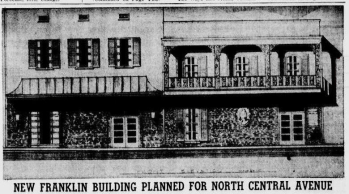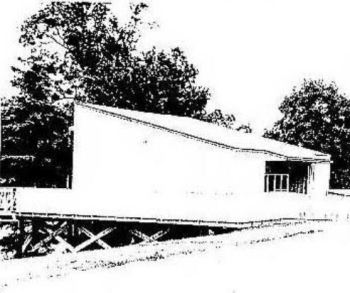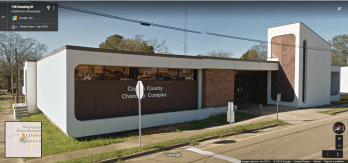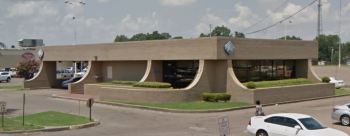This post is a follow up to a series begun a few weeks back that stimulated quite a bit of conversation about the appreciation of buildings from the late 1960s and early 1970s that are now reaching the golden fifty-year mark when they can be considered for listing on the National Register of Historic Places. The buildings in today’s post are less than seven years from reaching their fiftieth birthday. Below is a brief Delta Democrat Times article that highlights a Delta design that received recognition from the Mississippi Chapter of AIA at their annual convention in 1975.
Unlike our first 1970’s awards post, today’s building is still standing. The Delta Mental Health Center is just one of the buildings recognized at the 1975 Mississippi AIA conference. I’ve yet to identify any other buildings that received an award at the conference.
Winning Design
The Greenville architectural firm, Virden & Roberson, Ltd., received the 1975 Jones Woodward Memorial Award for their design of the Delta Community Mental Health Center, 1654 E. Union, Greenville, and in Cleveland. The award–given for the best architectural use of pre-cast concrete for a building in Mississippi–was established in 1973 to honor the late Jones Woodward, a salesman, designer and consultant for Jackson Stone Co.
–Delta Democrat Times November 21, 1975
I also came across an earlier article that shed some more light on the building and the award selection process.
G’villians win
A Greenville building and its Greenville architects have won the coveted annual Jones Woodward Award in statewide competition sponsored by the Mississippi Chapter of the American Institute of Architects. (AIA)
The Greenville firm of Virden & Roberson was awarded the third annual Jones Woodward Award for outstanding architectural use of pre-cast concrete for its design of the Delta Mental Health Center in Greenville, according to William V. Lack, AIA, of Jackson, 1975 Honor Awards Committee chairman for the state chapter.
Dean William G. McMinn of the School of Architecture of Mississippi State University made the award at the state architects convention in Biloxi after a blue ribbon panel of out-of-state architects selected design winners from among the 25 state structures entered in the competition.
The Delta Mental Health Center is located near the Delta Medical Center in Greenville.
Judges who selected the building for the award were James E. Ellison, AIA, administrator of Education and Research of the American Institute of Architects; Sam Hurst, FAIA, former dean of the School of Architecture of the University of Southern California; Harlan McClure, FAIA, dean of the College of Architecture of Clemson University and Alan Taniguchi, FAIA, dean of the School of Architecture of Rice University.
–Delta Democrat Times August 10, 1975
In early June, this year’s MHT historic preservation conference will feature a blue ribbon expert on buildings of this era and what their preservation might mean. Last week’s post about the MHT conference mentioned that Liz Waytkus, Executive Director of Docomomo US, will be a special guest at the conference. If you’re unfamiliar with Docomomo, they are an international organization interested in the Documentation, and Conservation of the Modern Movement. Docomomo US has been addressing the fact that iconic buildings and sites that were completed outside of the chronological period that most associated with the Modern Movement can be places that have expanded the tenets of the Modern Movement in meaningful and provocative ways. Several places, such as the AT&T Building in Manhattan and the Thompson Center in Chicago, have become endangered and Docomomo has engaged their membership about whether or not to advocate for these buildings preservation. Hopefully, Ms. Waytkus can share with conference-goers some insight to how to advocate for soon-to-be-historic places.
Categories: Architectural Research, Cool Old Places, Delta, Greenville, Historic Preservation, Hospitals/Medical, Mississippi Heritage Trust, Modernism, Ocean Springs, Preservation Law/Local Commissions, Recent Past, Renovation Projects







I for one derive huge enjoyment from the posts about 1970s Mississippi architecture. I welcome more! Thank you! (It is gladdening to see that the health center in Greenville still obtains.)
LikeLiked by 1 person
I am sorry Thomas, but I would urge people not to preserve that windowless, featureless, plain box. It shows that 1975 was an atrocious year for Mississippi architecture if that building is the best one.
LikeLike
This is an email I was sent recently. I would argue that if a 1970s building needs to be preserved, it is the following one that unfortunately will not be.
Get Up On The Roof of Amity Elementary School!
This unique 1970’s school is going to be demolished at the end of June and students will move to the new school being built next door to it. The school reflects the energy-crisis sensibility of the time and the interior is uniquely hip!
We will be able to tour this one-of-a-kind Boise school inside and out and you will be able to appreciate the view from the roof. Before it comes down, you can go up!
Boise Architectural Historian Dan Everhart will lead the tours.
Join us. Register to secure your spot. Only two groups of 20 will get to tour the school so register today. We will have 2 tours running consecutively– one starting at 10AM and the other 11:15AM.
The tour is free and a donation of $5 is suggested the day of to support Preservation Idaho and our education and advocacy work.
LikeLiked by 1 person
I don’t think it is accurate to call the building windowless when one of its few outward expressions is a massive window.
LikeLike
I pause to enter this fray, but while this building might not be to my taste (or to many others’), it clearly represents two significant influences in architecture of the 1970’s: (1) The earth-sheltered building strategy is one of the (sadly, short-lived) energy-conservation innovations that followed the energy crisis associated with the rise of OPEC and the oil embargo of the early 1970’s. Consult your tattered copy of the Whole Earth Catalog for more information. (2) Specific to education facilities, this would have been the height of the “open classroom” movement when multiple class groups were clustered into large pods, most of which were windowless (whether located underground or above) as a matter of educators’ programmatic preference – not architects’ aversion to daylight and views.
It doesn’t make the building any more handsome or welcoming, but its significance as architectural history is evident.
LikeLiked by 1 person
I like this building Thomas, and agree about the windows providing relief for this otherwise austere concrete box (sorry William). I note that the 1973 plans for this building and for what appears to be a modest, less expensive version in Cleveland at 113-120 S. Davis Ave (with a much larger and later addition?) are in the Rosamond Architectural Records at MSU.
LikeLiked by 1 person
Thank you for the info about the plans. I am curious about the public spaces in these buildings. The structure on Davis suffered from that addition, but the significant downside of the building is the lack of the landscaping that contributes quite a bit to the Union St building.
LikeLike